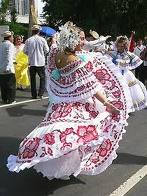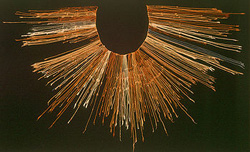
The Column of Lasting Insignificance: November 27, 2010
John Wilcock
Cruising to Peru
Monday: Our first stop on Holland America’s good ship Rotterdam this morning was at Cabo San Lucas, and perusing the giveaway Gringo Gazette (its bylines included Chuck Wagon and Bud Light), I noted that among my options was an opportunity to volunteer at the local Humane Society to walk dogs in the desert or pay Cabo Adventures 499 pesos to take part in a Sunset Turtle Release on  “a virgin beach.” Instead, I noted that the paper’s publisher, Carrie Duncan, seemed to be quite a character and set off for the tabloid’s office hoping to meet her. In a lengthy editorial, Ms. Duncan revealed herself as veteran motorcyclist who’d ridden an early Honda all over Mexico, taken it on trains, tossed it on to a banana boat in Honduras, and into the back of her plane. “I’ve spent a lifetime buying, selling, and trading bikes,” she wrote, “big road bikes, little scooters, trail bikes built for rock climbing and dirt bikes for getting dirty.” She’d also flown all over the place, too, in her own plane, undergoing hair-raising experiences too numerous to count. “There’s an old joke about pilots in trouble calling for help in the tower,” she said, (from which) “the guys radio back that we had better give our souls to the Lord because the plane has got our ass.” I was looking forward to meeting the venerable Carrie Duncan, but sadly she wasn’t in town and so for me, it was back to the cruise.
“a virgin beach.” Instead, I noted that the paper’s publisher, Carrie Duncan, seemed to be quite a character and set off for the tabloid’s office hoping to meet her. In a lengthy editorial, Ms. Duncan revealed herself as veteran motorcyclist who’d ridden an early Honda all over Mexico, taken it on trains, tossed it on to a banana boat in Honduras, and into the back of her plane. “I’ve spent a lifetime buying, selling, and trading bikes,” she wrote, “big road bikes, little scooters, trail bikes built for rock climbing and dirt bikes for getting dirty.” She’d also flown all over the place, too, in her own plane, undergoing hair-raising experiences too numerous to count. “There’s an old joke about pilots in trouble calling for help in the tower,” she said, (from which) “the guys radio back that we had better give our souls to the Lord because the plane has got our ass.” I was looking forward to meeting the venerable Carrie Duncan, but sadly she wasn’t in town and so for me, it was back to the cruise.
Tuesday: Elizabeth Taylor’s house features prominently on many tours of Puerto Vallarta, although not on the one I took. The once tiny fishing village (current pop: 250,000) still revels in the tale of how she came to live here after wooing Richard Burton during the making of Tennessee Williams’ Night of the Iguana (1964) — a romance, a scandal, a film that first put Vallarta on world maps. One tour for the magically inclined included a meet-and-greet with Huichol Indians, whose craftwork features glass beads set into beeswax and yarn work embodying ancient symbols such as iguanas (prophets), turtles (assistants to the rain god), and peyote (symbol of success). Peyote is a big deal with the Huichol, most of whom dwell in the eastern Santa Madre mountains. But, this being Jalisco state, tequila is even more prominent, and after free samples at one stop, many tourists succumbed to the pitches of eager salesmen.
Wednesday: The first of two consecutive days at sea with no stops. Last night’s dinner was as boring as I’d expected, but as I get assigned randomly to a different table each night, there’s always hope that things will get better. It’s a pretty forlorn fancy because not only are most cruisers as old, or older than myself, but conversation is restricted. Religion, sex, politics, drugs — anything provocative — are by unspoken agreement, taboo topics. So, grouped with the usual septuagenarians tonight, I was pretty much staying out of it, virtually somnolent, when suddenly I heard the words “medical marihuana” and jerked to attention. Yes, indeed, they were all discussing it avidly and excitedly — and they were all in favor! I could hardly believe my ears. Half a century ago, I submitted, not only were all my friends smoking pot every day, but all expected it to be legalized by the time the Vietnam war was over (which was the other preoccupation of the underground press). No luck then, but now here it was, Anno Domini 2010, and even 80-year-olds were glorifying grass!
Thursday: Tonight’s dinner seemed to be another unpromising crowd, but when the initial conversation flagged I recounted my experiences of yesterday and, to my amazement, we were off again. This group also positively purred with delight at the opportunity to talk about a hitherto unmentionable subject, nevertheless one that had clearly been on their minds. Something clicked: I had accidentally discovered a way to bypass dullard dinners. From henceforth I could be a raconteur. All the subjects I could talk about: my interview with Marilyn Monroe, my time with Andy Warhol (“who’s he?”), my worldwide travels, my writing about South America (we were en route to Peru), underground politics, the Sixties — the list was endless. For a brief two weeks, I could be an entertainer with a captive audience yet, a different one each night.
Friday: One of the original banana republics, for long the fief of the United Fruit Company, Guatemala has an unhappy history of manipulation by the CIA which in the 1950s regarded the country as a dangerous communist outpost. With scant regard for the actual population, the CIA succeeded in ousting democratically-elected president Jacobo Arbenz whom they found guilty of expropriating unused land and turning it over to the peasants. (How dare he!) “Economic colonialism” screamed most of the world’s press about the overthrow, and political chaos lingered in the country for many years.
Today’s 90-minute drive from the port to Antigua, a small colonial city surrounded by volcanoes, dropped us at a jade factory, several blocks walk from the Plaza Mayor: a typical ploy of tour companies delivering a captive audience to a salesroom. As it happens there wasn’t much to see in town, just the familiar 18th century buildings and a museum displaying ancient costumes, so I soon trekked back to the bus and surreptitiously smoked a joint while waiting for our return journey. The tour cost $44 — but it was a long (though unrewarding) ride, each way. Today’s movie in the Wajang Theater onboard is Sex and the City 2. Thanks, but I’ll pass.
Saturday: Nicaragua is a very poor country, still something of a victim of years of civil war and the anti-communist paranoia of Ronald Reagan and American right-wingers back in the late 1980s. Daniel Ortega, then president, was demonized by Reagan — who illegally sold arms to Iran to fund the Contras (counter-revolutionaries) — and after failing to be re-elected spent several years in the wilderness. Now 65, Ortega regained the office in 2006 and, despite a career with which even American liberals find fault, is understandably appreciated more by his fellow Nicaraguans. When the tour bus from the port of Corinto dumped us at the cathedral in nearby Leon, I got talking to the man who ran the sidewalk bar across the street and he reminded me that whatever Ortega’s faults (and apparently inevitable re-election next year) he was a definite improvement on the man he replaced. This was the brutal strongman Anastasio Somoza who, with his family, ran the country (with avid U.S. approval) for 43 years, in what Wikipedia describes as a “hereditary dictatorship.” The last of this sleazy bunch outlawed opposition parties, embezzled international funds sent to the country after a devastating earthquake, and in 1978 fled to Paraguay where he was assassinated the following year.
Sunday: Long-tailed black and grey cats predominated in today’s Hallow’en parade beside the pool on the Lido deck, but the chicken-costumed MC chose as the winner a lady encased in a golden Statue of Liberty costume with spiky halo and carrying a torch. Crew members were hawking piles of T-shirts from every stop on the cruise — Puerto Vallarta, Panama, Lima, etc. — although there didn’t seem to be many takers. But everything contributed to an unusually festive day, including the cardboard pumpkins and other insignia with which some foresighted passengers had brought to adorn the doors of their cabins. Some people spend much of their life on one cruise after another. At dinner, one burly fellow across the room was wearing a Stetson which he kept on throughout the meal (“not exactly etiquette,” said my neighbor). In the library a huge jigsaw puzzle spreads across a table, fiddled with by a succession of passers-by over the week, each of whom fits in a piece or two before moving on.
Tuesday: From the port of Fuerta Amador to downtown Panama City’s older section (a pretty unrewarding trip) costs $25 by taxi but only $8 to return. A minuscule tourist office dispenses literature which includes El Visitante, a typical tourist guide This is unusually frank about some of the country’s problems. It reports, for example, that the country has dropped 30 places (to 81st) in a ranking of countries with press freedom,  and also that it’s one of a dozen countries on an “unskilled” list, defined as a “difficult” site for talent and skilled labor. Another rag, El Siglio, adds that Panama is still smarting from Time magazine’s accusation that its president, Ricardo Martinelli’s rule is “arbitrary and authoritative.” A few days hence, after the Rotterdam’s departure, is scheduled Panama’s annual folklore parade when 1,000 Polleras demonstrate their dancing skills, warned by the tabloid that “(any) lady who wishes to participate in the parade should know how to properly wear and dance the pollera.” This beautiful dress needs 12 yards of material to make in a process that can take up to a year. (The dance has been described as “a metaphor for the courtship process.”)
and also that it’s one of a dozen countries on an “unskilled” list, defined as a “difficult” site for talent and skilled labor. Another rag, El Siglio, adds that Panama is still smarting from Time magazine’s accusation that its president, Ricardo Martinelli’s rule is “arbitrary and authoritative.” A few days hence, after the Rotterdam’s departure, is scheduled Panama’s annual folklore parade when 1,000 Polleras demonstrate their dancing skills, warned by the tabloid that “(any) lady who wishes to participate in the parade should know how to properly wear and dance the pollera.” This beautiful dress needs 12 yards of material to make in a process that can take up to a year. (The dance has been described as “a metaphor for the courtship process.”)
Thursday: Tomorrow we’ll be in Peru and after reading the newly-republished edition of my Occult Guide to South America I regaled my dinner companions with tales of the glorious Incan empire which was largely liquidated by the Spanish invaders in the 16th century. Scheduled tours include Machu Picchu and the ancient mud city of Chan Chan which twice-yearly rain had not washed away.
Lacking wheels, or even a written language, the Incas nevertheless were so efficient they utilized runners to transfer information as much as 100 miles in a single day, a feat that a Spanish mailman on horseback was unable to duplicate a century later. Each runner would cover one mile before passing the package along to the next, and so on for days on end. What they carried was the quipu, a bundle of strings of different colors and lengths hanging from a central cord, the ingredients representing statistics, taxes, census figures, military orders — “everything in the empire that can be counted.” Only a few survive, in museums around the world, but I have long felt that the quipu could be a great fashion artifact, reproduced in a classy way and hung on hipster skirts and dresses.
to the next, and so on for days on end. What they carried was the quipu, a bundle of strings of different colors and lengths hanging from a central cord, the ingredients representing statistics, taxes, census figures, military orders — “everything in the empire that can be counted.” Only a few survive, in museums around the world, but I have long felt that the quipu could be a great fashion artifact, reproduced in a classy way and hung on hipster skirts and dresses.
Friday: At Lima’s port of Callao, the dock offers nothing beyond big cranes and grubby commercial activity. Taxis run to town but most passengers take advantage of a free bus to the classy Miraflores section (“the Beverly Hills of Lima”) sponsored by the H. Stern jewelry chain which greets everybody with a free pisco drink (Peru’s wine-based alcohol). Trouble is there’s nothing there but the sea, costly shops, and a few hotels, and downtown is still a taxi ride away. Among the selection of perfumes in one souvenir shop was one named after soccer player David Beckham. I tried to buy a newspaper (as I had unsuccessfully tried at every previous stop) but there were none to be found. Although every passenger receives a daily print-out of stories condensed by the New York Times it is insufficient to satisfy a news junky such as myself. Even at the Lima airport (which charges a rip-off $31 “exit fee”), only Peruvian papers were available. Back home on Lan Chile, a comfortable airline.
AT HER FINAL CHAT, the Rotterdam’s cruise director Lizabeth Knight recounted the most common questions she and her ilk are asked during cruises:
++Does the ship generate its own electricity?
++Do I have to leave the ship to go on a shore excursion?
++Is the water in the toilets salt water or fresh water?
++Does the crew sleep onboard?
++What side of the ship will the whales be on?
++Where’s the elevator that will take me to the back of the ship?
++When I go to the photo gallery, how will I know which of the photographs are mine?
